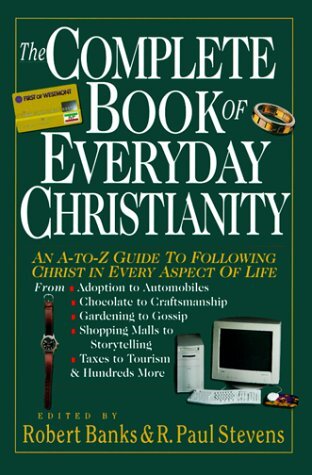Cohabiting
Book / Produced by partner of TOW
The phenomenon of a man and woman living together under the same roof as though they were husband and wife, yet without a solemnized wedding and without regarding themselves as married, is a pervasive trend in North American society. Some researchers predict that in a few years almost all young adults will live together before marriage and that this will soon be considered the normal way of courting (see Dating) and the equivalent to engagement. This phenomenon is not unique, however, to the Western world, since many societies have marketplace marriages—that is, a couple simply decide to live as married, raise a family and avoid the expense and hassle of a huge wedding.
Frequently the church in these countries faces a difficult challenge—whether to recognize this couple as married or to treat them as living in sin and therefore in need of church discipline. Some well-meaning church leaders, anxious to get these people married, rush them to the altar, only to find that the relationship, while reasonably stable when the two were living together, sometimes becomes fragile after marriage. Sometimes the marriage ends in divorce. This raises a profound theological question: When are two people married? Are they married when they have sexual intercourse? when they cohabit and share life fully? when they make their marriage official in a public ceremony? It also raises a spiritual question, for many declared Christians have adopted this pattern either secretly (by spending weekends in each other’s apartments) or openly (all the while retaining their membership in a church).
Cohabiting as Marriage Preparation
Many people think of cohabitation as a trial marriage, without using those words per se, since it simulates fully married life and is preferable to the alternative of dating. The problem, however, is that marriage cannot be simulated. It is an unconditional covenant of belonging that is made by vows and promises, by public approval and consent (leaving one’s father and mother), and that is sealed and consummated with sexual intercourse. The only way to try marriage is to get married. Karl Barth insightfully notes that a person who enters marriage must renounce the thought of ever leaving it, which is the very thing cohabitation keeps open. So a couple is either married, unmarried or pretending. It is the pretense that makes cohabitation so illusory a way of assessing marriageability.
Living together is an unwritten contract to meet each other’s needs and to make each other happy. It is a convenient relationship without mutual cross bearing and self-sacrifice. There is always the freedom to break the contract if one does not meet the terms. What often happens when a couple who has lived together gets married, especially if they have not been prepared through adequate counseling, is a shocking change in the dynamics and politics of their relationship. A comfort factor sets in. They really belong to each other now and therefore relax some of their efforts to hold on to their live-in companion. On a deeper level, many begin to realize that they are not just lovers but husband and wife, and revert to models they have learned from their families of origin. The problem is not marriage—as is often alleged—but poor preparation for marriage through cohabitation.
Research indicates that couples who have lived together before marriage, in comparison with those who have not, express higher levels of uncertainty and assertiveness and lower levels of conflict avoidance, marital satisfaction and sharing. Rosanne Lyster notes that the absence of a true honeymoon is a significant loss to the marriage. One purpose of the honeymoon is the establishment of positive memories that can hold a marriage together through difficult times. Though most cohabiters take a trip after their wedding, it is not a time of unique sexual pleasure and mutual discovery. Neither were their first few days of living together a honeymoon, since so often moving in was not a concrete decision but just seemed to happen. Further, since most cohabiting couples believe that they are already prepared for marriage, they are more resistant to premarital preparation, even though they may need it as much as others who approach marriage by dating.
The quality of the living-together arrangement has also been the subject of research. Its conditional nature opens the door to exploitation, with the intimacy of short-term gains making it too easy to rationalize one’s behavior, to overlook or minimize things that are important to building a permanent relationship or to disregard the long-term welfare of oneself or the other person. Experience has shown that women are more easily exploited than men when it comes to living together. When conception occurs, the couple is often then faced with the decision of whether to keep their child (see Abortion) or whether to marry and give the child a permanent family shelter. As a young boy in a cartoon said to his pal, “First my mom and dad were living together. Then I came along. Now all three of us are living together.”
Are They Married?
From a biblical perspective, cohabiting rather than marrying is a stolen covenant. It is not stolen because the couple has failed to register their marriage in the town hall or pay for an expensive wedding in the church. These are important but not essential. The covenant is stolen because the benefits of marriage are being enjoyed without the presence of all three constituent parts of the full covenant, which are found in Genesis 2:24, Matthew 19:5 and Ephes. 5:31—leaving (public wedlock), cleaving (social unity and friendship) and becoming one flesh (sexual consummation). The abiding absence of any one of these three dimensions means that the couple is not married. They may be pretending, but there is something missing.
Marriage is a mystery (Ephes. 5:32), and Scripture raises as many questions as it answers on this issue. Jesus, when pressed on the divorce question, said, “Therefore what God has joined together, let man not separate” (Matthew 19:6). This raises the question of whom God joins together: those who have had a church wedding? those who live together? those who have had sex? If the last option were true—namely, that one is married to every sex partner—many people are polygamists or have had multiple divorces. Though Paul warns that a person who has sex with a prostitute has become one body with her—there is a transcendent bond—he does not say they are married in 1 Cor. 6:16. Sex before and outside of marriage is a marriagelike experience but still less than marriage itself.
Marriage is essentially a covenant marked by unconditional relational belonging (“I take you to be . . .”). Christians do not have a monopoly on covenant making, and many not-yet Christians, stumbling on God’s plan of leaving, cleaving and becoming one flesh, have unknowingly enjoyed the divine blessing. Some Christians, in spite of their church wedding, have never really made a covenant. They may have been manipulated into the marriage, may refuse each other sex or may fail to bless their spouse, and so they are not actually married by God. On this point Karl Barth gives wise counsel that we should always cling to God’s yes and not quickly conclude that our relationship lacks the divine blessing. So it is a mystery. As such, marriage is to be treated not thoughtlessly but reverently and in the fear of God. It is a matter of worship and faith. Marriage is a spiritual discipline.
Marriage is also a process. We err in reducing getting married to an event: the pronouncement by the pastor (“I declare them husband and wife”), the signature in the book (a legally binding agreement), the first act of intercourse (which may have occurred before the wedding or on the wedding night), the end of the honeymoon (which could have been a disaster), the conception of the first child (which might not even be physically possible). Each of the three constituent parts of the marriage covenant is a progressive and continuing challenge. Leaving one’s father and mother is a lifelong process and is rarely fully accomplished on the wedding day, even if the parents “give” their son or daughter away. Cleaving is a dynamic process, because a marriage relationship is always changing and partners find over time that their spouse is not the same person they married. Becoming one flesh is also a process, since the line between heavy petting and penetration is fine indeed and mere physical touching may lack the gift of self which is the essence of the sexual act.
So it is the intent, willingness, personal capability and action on all three dimensions of the marriage covenant—whether or not the persons acknowledge God—that makes a couple married. The abiding absence of any one of these, such as exists in cohabiting arrangements, means that the couple is not married. In the Western world, the ideal order is cleaving (friendship), leaving (formal wedlock) and becoming one flesh (full sexual union). Under the arranged-marriage system in the East, the usual order is leaving, becoming one flesh and cleaving (see Genesis 24:67). In the living-together arrangement, provided it leads to marriage, the order is cleaving, becoming one flesh and leaving. God’s grace may work through each of these arrangements, and for the couple living together there is hope for a good marriage, provided there is repentance and a willingness to prepare properly for full marriage. Some churches have found the discipline of a couple’s separating publicly for an extended period of time prior to a church wedding to be a constructive step for the couple and the church.
In conclusion, living together is not a good way to try marriage, because marriage cannot be tried. Neither is living together good marriage preparation. So the church has a unique opportunity to speak prophetically regarding a major trend in the Western world, enfolding couples living together in constructive pastoral care, all the while confessing that legal marriage or a mere church wedding does not guarantee that God has brought two people together. Marriage is a mystery (requiring faith) and a process (requiring continuous intentionality), something much more than living together.
» See also: Dating
» See also: Marriage
» See also: Promising
» See also: Sexuality
References and Resources
R. Anderson and D. Guernsey, On Being Family: Essays in a Social Theology of the Family (Grand Rapids: Eerdmans, 1985); R. F. Lyster, “Implications of Research on Cohabitation for Marriage Preparation,” Marriage Education News 8, no. 1 (Spring 1995) 1-2; J. H. Olthius, I Pledge You My Troth: A Christian View of Marriage, Family, Friendship (New York: Harper & Row, 1975); W. R. Schrumm, “Sex Should Only Occur Within Marriage” (Department of Family and Child Development, Kansas State University, 1984); R. P. Stevens, Married for Good: The Lost Art of Remaining Happily Married (Downers Grove, Ill.: InterVarsity Press, 1986).
—R. Paul Stevens





